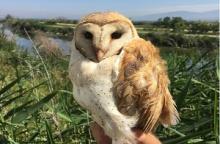- About us
- Research
- Students & Teaching
- Seminars & Events
- Directories
- Booking Rooms & Equipment
- עברית
Home » Prof. nathan - movement ecology and sex are linked to barn owl microbial community composition
The behavioural ecology of host species is likely to affect their microbial communities, because host sex, diet, physiology, and movement behaviour could all potentially influence their microbiota. We studied a wild population of barn owls (Tyto alba ) and collected data on their microbiota, movement, diet, size, coloration, and reproduction.
The composition of bacterial species differed by the sex of the host and female owls had more diverse bacterial communities than their male counterparts. The abundance of two families of bacteria, Actinomycetaceae and Lactobacillaceae, also varied between the sexes, potentially as a result of sex differences in hormones and immunological function, as has previously been found with Lactobacillaceae in the microbiota of mice. Male and female owls did not differ in the prey they brought to the nest, which suggests that dietary differences are unlikely to underlie the differences in their microbiota. The movement behaviour of the owls was associated with the host microbiota in both males and females because owls that moved further from their nest each day had more diverse bacterial communities than owls that stayed closer to their nests.
This novel result suggests that the movement ecology of hosts can impact their microbiota, potentially on the basis of their differential encounters with new bacterial species as the hosts move and forage across the landscape. Overall, we found that many aspects of the microbial community are correlated with the behavioural ecology of the host and that data on the microbiota can aid in generating new hypotheses about host behaviour.
Photo by Gabe Rozman
